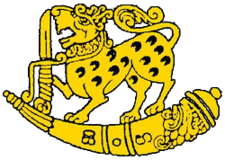Swords were rarely fixed because the flash of their blades could give the bearers away and because it lessened their accuracy of the rifle. To this day, swords were not fixed on ceremonial occasions.
The need to move quickly in rescue or rearguard actions, or to form a screen, required fast marching and occasional double marching. As compared to the regular infantry pace of 120 per minute, the Rifle pace is 140 per minute. On ceremonial parades march pasts were done in both quick and double time, the latter 180 paces to the minute.
Avoiding unnecessary commands and demonstrating alertness and quickness, in close order drill on the order 'quick (or double) march' Riflemen came directly to the 'trail', and stepped off with the rifle held balanced in the right hand and parallel to the ground, a position suited to movement in battle.
Subsequently, on the order 'halt', rifles were returned to the 'order' without further command. On sentry duty the rifle was cradled close to the body on the left forearm, called the 'carry' (sometimes called the cradle'), a comfortable position where the rifle was ready for instant use. The 'march at ease' position with the rifle slung over the right shoulder, muzzle down, a comfortable position which was less fatiguing, and which protected the barrel from the rain, was originated by the Green Jackets.
However, the Royal Green Jackets were equipped with the small arms 80 Rifle which was too short to allow the old 'at ease' to be adopted. Hence, the small arms 80 was kept in the 'shoulder' for 'at ease' and was held across the body for 'stand easy'. They no longer used the 'carry'.
Camouflaged modern combat dress was anticipated by the wearing of buckskins in North America, the green jacket and black leather in Spain and, later, black buttons. These buttons were all of one size, whether worn in front of the tunic or on pockets; the reason was the practical one should an important button be lost it could be replaced by one that would fit, from a less essential place. Cloth rank badges and all leather equipment, boots, belts, scabbards, et cetera were black. Up until World War I (WWI) officers of the Rifle Brigade wore black Sam Browne belts (other regiments wore brown) with two shoulder straps so that from a distance they would appear to have the same equipment as their men and also denote that in peacetime they were always ready for action.
Officers, warrant officers and sergeants wore black leather cross belts over their left shoulder. Mounted on the front was a lion head with a chain attached to a whistle (The Royal Winnipeg Rifles had replaced the lion's head with a buffalo head and changed the whistle holder to resemble a quiver of arrows), with the regimental badge centred between. The whistle holder was on the right-, the whistle was drawn and held in the left hand while the right grasped the sword. Whistle lanyards were worn on the right shoulder for left hand use of the whistle.
Tradition is essential in a regiment to develop that pride of unit, morale and esprit de corps which bring success in war. Our traditions are founded on substance and not to belittle those of others and must be known and understood by every member of the Regiment. This is particularly important not just for recruits but for those who have joined after training or service elsewhere where they have learned habits which must be discarded before they can claim the proud title of 'Rifleman'. False customs acquired through ignorance, decree or whim must be vigilantly guarded against.
The import of Bouquet, de Rottenburg, Coote Manningham, Moore, Crawford and in particular the Rifle Brigade with whom The Royal Winnipeg Rifles were privileged to be allied since 1923, should be known to all. This alliance was transferred to the Royal Green Jackets in 1966 and we are proud to retain our links with a Regiment of such famous origins.

An artist's impression of an officer' of the British Rifle Brigade (Green Jackets)

An artist's impression of a Rifleman of the British Rifle Brigade (Green Jackets)





